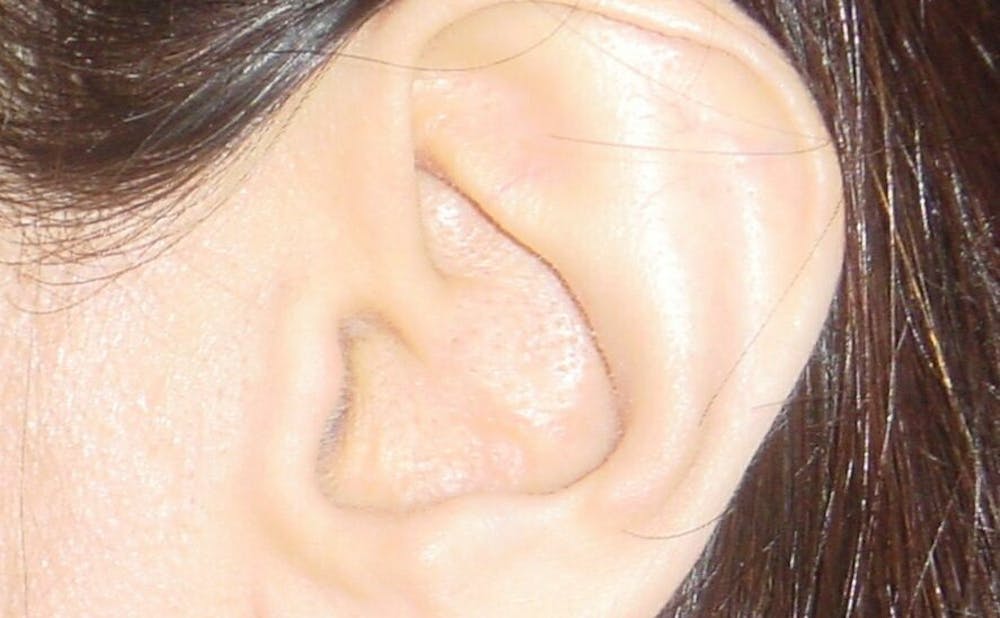To the majority of people who cannot wiggle their ears, a new study offers a consolation—all humans can wiggle their eardrums, just by moving their eyes.
The study, led by Duke neuroscientists and neurobiologists, showed a direct link between eye movements and vibrations in the eardrum—a thin membrane in the ear that amplifies and conducts sound. When the participants kept their head still and glanced to the left, their eardrums bulged to the right and vibrated. When they glanced to the right, the eardrums bulged in the opposite direction.
“We had been looking in the brain for quite a few years,” said Jennifer Groh, professor of neurobiology, psychology and neuroscience and senior author of the study. “And we were finding evidence everywhere we looked that eye movements affect auditory processes.”
Even more surprising was that these vibrations happened a fraction of a second before the eyes started moving. This ruled out any possibility that the ears were responding or reacting to the movements in the eye.
“This is a proof of principle that the sensory systems are interacting with each other at very early points in [brain] processing,” Groh said.
To measure the eardrums, the researchers asked participants to look at lights placed at different angles in a dark, silent room. They then used small, earbud-like microphones to pick up the imperceptible airwaves generated inside the ear.
Scientists have known about the existence of these otoacoustic emissions—usually faint echoes of heard sounds, sent back by the cells that received them—for at least 40 years. But the discovery that the eardrums move whenever the eyes move, even without any external noise, came as a total surprise.
“We were actually looking for something entirely different,” said Capt. Kurtis Gruters, a soldier-scientist at Fort Bragg and a co-first author of the study who earned his Ph.D. at Duke in 2016. “We were really surprised when we started seeing these large, consistent oscillations.”
The research began with a thought experiment during his senior year of college, Gruters said. As a music major and a percussionist, he was interested in how sight and sound interact, and he guessed something interesting would happen if he tested the eardrums for vibrations. But the study quickly grew out of control, and what began as a summer project ended up taking more than five years.
“We realized it was actually starting to work, and we started thinking about how important the result would be if we nailed it right,” Gruters said. “It became my entire dissertation.”
The findings, published on Jan. 23 in the Proceedings of the National Academy of Sciences, add to the mounting evidence that our senses are intimately connected, working together to shape how we perceive the world around us.
“In general, the brain is not trying to see or hear,” Groh said. “Rather, it’s trying to understand what is happening. And it’s got a lot of spies giving it intelligence about the events in the world.”
She explained that the eyes and ears work together all the time. For example, we listen better when we can also read lips, our sight helps us focus on one voice in a crowd and our pupils dilate when we’re paying extra attention to another person’s words, almost as if the eyes are acting “a little more like the auditory system.”
The Duke scientists found the same eye-eardrum link in rhesus monkeys, and Groh expects to find it in other animals as well, such as rodents and cats. Because it is a common trait across different lineages and species, it could be an evolutionary advantage. But David Murphy, a graduate student in Groh’s lab and the other co-first author of the study, said it was too soon to tell.
“That is the general assumption,” Murphy said. “But it could be a nonessential product of something else going on.”
Meanwhile, Murphy said the findings could have profound implications in understanding nervous conditions like traumatic brain injury, which affects many soldiers and professional football players, and degenerative disorders such as Parkinson’s disease.
But Gruters said he was most excited about how the study would change scientific thinking. Although most scientists believe our sensations remain separate until they are processed in the brain, the findings suggest that our two main senses—seeing and hearing—are linked from the very start. Questions remain over which other senses are involved.
“We think this is opening up a Pandora’s box,” Gruters said.
Get The Chronicle straight to your inbox
Signup for our weekly newsletter. Cancel at any time.

